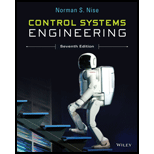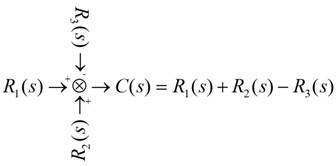
The four components of a block diagram for a linear, time-invariant system.
Answer to Problem 1RQ
Signals, system, summing junction and pick-off points are the four components of a block diagram for a linear, time-invariant system.
Explanation of Solution
Introduction:
Linear time invariant system (LTI system) represents a class of systems which are linear as well as time invariant. It means that for LTI systems the out possess the linear relationship which is same as the linear combination of individual responses. Also, the output does not depend upon the time at which the input is applied. These systems are easy to represent and understand.
To analyse the control system mathematically, a block diagram of the control system is constructed. The basic components of a block diagram for a linear, time-invariant system as follows:
- Signals: Signal is one of the basic components. We have input signals and output signals.
- System: System is one of the most significant components of the block diagram which connects input and output.
- Summing Junction: Summing junction is the component of the block diagram where the signals get combined as follows.

- The pick-off points: Pickoff points are those points where the signal get into different components.

Conclusion:
Thus, four basic components of a block diagram for a linear, time-invariant system are signals, system, summing junction and pick-off points.
Want to see more full solutions like this?
Chapter 5 Solutions
Control Systems Engineering
 Elements Of ElectromagneticsMechanical EngineeringISBN:9780190698614Author:Sadiku, Matthew N. O.Publisher:Oxford University Press
Elements Of ElectromagneticsMechanical EngineeringISBN:9780190698614Author:Sadiku, Matthew N. O.Publisher:Oxford University Press Mechanics of Materials (10th Edition)Mechanical EngineeringISBN:9780134319650Author:Russell C. HibbelerPublisher:PEARSON
Mechanics of Materials (10th Edition)Mechanical EngineeringISBN:9780134319650Author:Russell C. HibbelerPublisher:PEARSON Thermodynamics: An Engineering ApproachMechanical EngineeringISBN:9781259822674Author:Yunus A. Cengel Dr., Michael A. BolesPublisher:McGraw-Hill Education
Thermodynamics: An Engineering ApproachMechanical EngineeringISBN:9781259822674Author:Yunus A. Cengel Dr., Michael A. BolesPublisher:McGraw-Hill Education Control Systems EngineeringMechanical EngineeringISBN:9781118170519Author:Norman S. NisePublisher:WILEY
Control Systems EngineeringMechanical EngineeringISBN:9781118170519Author:Norman S. NisePublisher:WILEY Mechanics of Materials (MindTap Course List)Mechanical EngineeringISBN:9781337093347Author:Barry J. Goodno, James M. GerePublisher:Cengage Learning
Mechanics of Materials (MindTap Course List)Mechanical EngineeringISBN:9781337093347Author:Barry J. Goodno, James M. GerePublisher:Cengage Learning Engineering Mechanics: StaticsMechanical EngineeringISBN:9781118807330Author:James L. Meriam, L. G. Kraige, J. N. BoltonPublisher:WILEY
Engineering Mechanics: StaticsMechanical EngineeringISBN:9781118807330Author:James L. Meriam, L. G. Kraige, J. N. BoltonPublisher:WILEY





